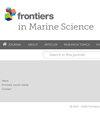堪察加半岛和北千岛群岛外太平洋非线性内波特征的年际变化
IF 3
2区 生物学
Q1 MARINE & FRESHWATER BIOLOGY
引用次数: 0
摘要
在北太平洋堪察加半岛附近,非线性内波(NLIWs)的研究仍然不够充分。本研究的目的是建立NLIW特征的分布模式及其显著变异性的原因。该研究使用了2015年至2024年的Sentinel-1雷达图像,以及来自FESOM-C潮汐模型、Landsat 8、Sentinel-2的数据,以及堪察加河狭鳕种群的估计。总共确定了3895次NLIW事件,揭示了高波活动的“热点”,主要是在第四千岛海峡以东,堪察加大陆架上,以及希邦斯基半岛周围。卫星观测得到的NLIW特征通过Shipunsky半岛附近的现场测量得到补充。NLIWs在夏季达到高峰,在冬季最不活跃。一年内发生的最大次数与强烈的地下斜斜、强化的潮汐流和弱风有关。“热点”与强烈的日潮流区域重合,表明地形上捕获的日内潮产生了许多NLIWs。研究结果还表明,内波对狭鳕幼鱼叶绿素-a分布的影响及其在支持狭鳕幼鱼取食基础中的潜在作用,表明内波在塑造当地生态系统中的重要性。本文章由计算机程序翻译,如有差异,请以英文原文为准。
Interannual variability of nonlinear internal wave characteristics in the Pacific Ocean off the Kamchatka Peninsula and the Northern Kuril Islands
In the North Pacific Ocean off the Kamchatka Peninsula, nonlinear internal waves (NLIWs) are still studied insufficiently. The purpose of the study was to establish patterns in the distribution of NLIW characteristics and the reasons for their significant variability. The study used Sentinel-1 radar images from 2015 to 2024, along with data from the FESOM-C tidal model, Landsat 8, Sentinel-2, and estimates of Kamchatka walleye pollock population. In total, 3,895 NLIW events were identified, revealing “hot spots” with high wave activity, mainly east of the Fourth Kuril Strait, on Kamchatka’s shelf, and around the Shipunsky Peninsula. NLIW characteristics obtained from satellite observations were supplemented by in-situ measurement near the Shipunsky Peninsula. NLIWs peaked in summer and were least active in winter. The maximum occurrence within а year was linked to the strong subsurface pycnocline, intensified tidal currents, and weak winds. “Hot spots” coincided with areas of strong diurnal tidal currents, suggesting that topographically trapped diurnal internal tide generates many NLIWs. Results also demonstrate NLIW influence on chlorophyll-a distribution and their potential role in supporting feeding base of juvenile walleye pollock, indicating the importance of internal waves in shaping the local ecosystem.
求助全文
通过发布文献求助,成功后即可免费获取论文全文。
去求助
来源期刊

Frontiers in Marine Science
Agricultural and Biological Sciences-Aquatic Science
CiteScore
5.10
自引率
16.20%
发文量
2443
审稿时长
14 weeks
期刊介绍:
Frontiers in Marine Science publishes rigorously peer-reviewed research that advances our understanding of all aspects of the environment, biology, ecosystem functioning and human interactions with the oceans. Field Chief Editor Carlos M. Duarte at King Abdullah University of Science and Technology Thuwal is supported by an outstanding Editorial Board of international researchers. This multidisciplinary open-access journal is at the forefront of disseminating and communicating scientific knowledge and impactful discoveries to researchers, academics, policy makers and the public worldwide.
With the human population predicted to reach 9 billion people by 2050, it is clear that traditional land resources will not suffice to meet the demand for food or energy, required to support high-quality livelihoods. As a result, the oceans are emerging as a source of untapped assets, with new innovative industries, such as aquaculture, marine biotechnology, marine energy and deep-sea mining growing rapidly under a new era characterized by rapid growth of a blue, ocean-based economy. The sustainability of the blue economy is closely dependent on our knowledge about how to mitigate the impacts of the multiple pressures on the ocean ecosystem associated with the increased scale and diversification of industry operations in the ocean and global human pressures on the environment. Therefore, Frontiers in Marine Science particularly welcomes the communication of research outcomes addressing ocean-based solutions for the emerging challenges, including improved forecasting and observational capacities, understanding biodiversity and ecosystem problems, locally and globally, effective management strategies to maintain ocean health, and an improved capacity to sustainably derive resources from the oceans.
 求助内容:
求助内容: 应助结果提醒方式:
应助结果提醒方式:


